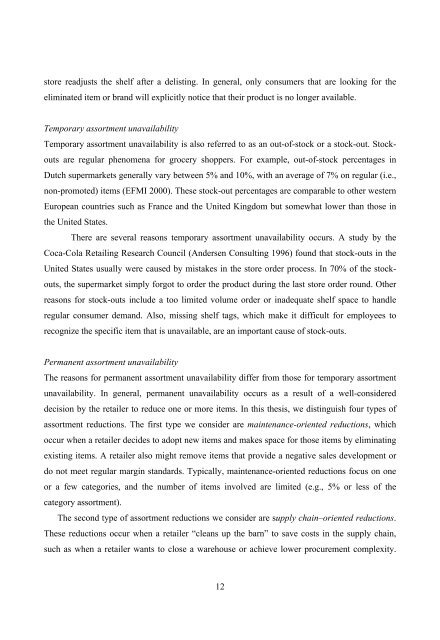Understanding Consumer Reactions to Assortment Unavailability
Understanding Consumer Reactions to Assortment Unavailability
Understanding Consumer Reactions to Assortment Unavailability
Create successful ePaper yourself
Turn your PDF publications into a flip-book with our unique Google optimized e-Paper software.
s<strong>to</strong>re readjusts the shelf after a delisting. In general, only consumers that are looking for the<br />
eliminated item or brand will explicitly notice that their product is no longer available.<br />
Temporary assortment unavailability<br />
Temporary assortment unavailability is also referred <strong>to</strong> as an out-of-s<strong>to</strong>ck or a s<strong>to</strong>ck-out. S<strong>to</strong>ck-<br />
outs are regular phenomena for grocery shoppers. For example, out-of-s<strong>to</strong>ck percentages in<br />
Dutch supermarkets generally vary between 5% and 10%, with an average of 7% on regular (i.e.,<br />
non-promoted) items (EFMI 2000). These s<strong>to</strong>ck-out percentages are comparable <strong>to</strong> other western<br />
European countries such as France and the United Kingdom but somewhat lower than those in<br />
the United States.<br />
There are several reasons temporary assortment unavailability occurs. A study by the<br />
Coca-Cola Retailing Research Council (Andersen Consulting 1996) found that s<strong>to</strong>ck-outs in the<br />
United States usually were caused by mistakes in the s<strong>to</strong>re order process. In 70% of the s<strong>to</strong>ck-<br />
outs, the supermarket simply forgot <strong>to</strong> order the product during the last s<strong>to</strong>re order round. Other<br />
reasons for s<strong>to</strong>ck-outs include a <strong>to</strong>o limited volume order or inadequate shelf space <strong>to</strong> handle<br />
regular consumer demand. Also, missing shelf tags, which make it difficult for employees <strong>to</strong><br />
recognize the specific item that is unavailable, are an important cause of s<strong>to</strong>ck-outs.<br />
Permanent assortment unavailability<br />
The reasons for permanent assortment unavailability differ from those for temporary assortment<br />
unavailability. In general, permanent unavailability occurs as a result of a well-considered<br />
decision by the retailer <strong>to</strong> reduce one or more items. In this thesis, we distinguish four types of<br />
assortment reductions. The first type we consider are maintenance-oriented reductions, which<br />
occur when a retailer decides <strong>to</strong> adopt new items and makes space for those items by eliminating<br />
existing items. A retailer also might remove items that provide a negative sales development or<br />
do not meet regular margin standards. Typically, maintenance-oriented reductions focus on one<br />
or a few categories, and the number of items involved are limited (e.g., 5% or less of the<br />
category assortment).<br />
The second type of assortment reductions we consider are supply chain–oriented reductions.<br />
These reductions occur when a retailer “cleans up the barn” <strong>to</strong> save costs in the supply chain,<br />
such as when a retailer wants <strong>to</strong> close a warehouse or achieve lower procurement complexity.<br />
12

















